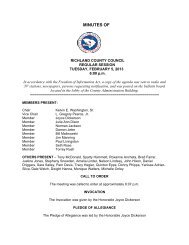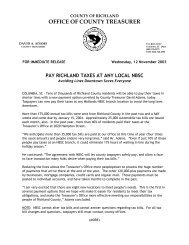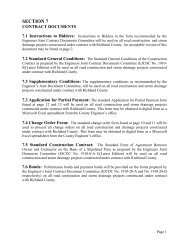Forest Acres and Arcadia Report - Richland County
Forest Acres and Arcadia Report - Richland County
Forest Acres and Arcadia Report - Richland County
You also want an ePaper? Increase the reach of your titles
YUMPU automatically turns print PDFs into web optimized ePapers that Google loves.
1935 with John Hughes Cooper as mayor. Eventually the town’s original boundaries<br />
exp<strong>and</strong>ed to the north.<br />
The town’s population exploded during the post-World War II era. In 1940, 323 people<br />
lived in <strong>Forest</strong> <strong>Acres</strong>. By 1950, the population had grown to 3,240. In 1970, the<br />
population stood at 6,808. By 1990, over seven thous<strong>and</strong> people lived in <strong>Forest</strong> <strong>Acres</strong>.<br />
<strong>Arcadia</strong> Lakes<br />
<strong>Arcadia</strong> Lakes was settled in the early twentieth century <strong>and</strong> became an incorporated<br />
community on 30 October 1959. In 1960, 316 residents lived in the town. By 1990 that<br />
number had grown to approximately 900. <strong>Arcadia</strong> Lakes occupies 2,228 acres.<br />
Recommendations<br />
In late October 2001, the consultants—using City of Columbia maps <strong>and</strong> a City of <strong>Forest</strong><br />
<strong>Acres</strong> map—conducted an extensive windshield survey over a two-day period. They<br />
drove every street <strong>and</strong> road in both cities <strong>and</strong> photographed several outst<strong>and</strong>ing examples<br />
of post-World War II domestic architecture.<br />
As a result of the survey, discussion with a few residents <strong>and</strong> research into the history of<br />
both cities, the consultants determined that potential historic districts could not be<br />
identified in either city. Several outst<strong>and</strong>ing early <strong>and</strong> mid-twentieth century dwellings<br />
st<strong>and</strong> in each city. <strong>Forest</strong> <strong>Acres</strong>, especially, possesses some of the most distinct post-war<br />
modernist houses in central South Carolina. In addition, each city might potentially hold<br />
significance in the area of social history as an example of suburban communities that<br />
developed during the post-World War II period. However, the consultants concluded that<br />
the resources that might potentially contribute to the significance of a district were<br />
distributed in a manner that compromised a potential district’s continuity. In other words,<br />
potentially contributing resources are interspersed with much later houses thereby<br />
compromising a potential district’s integrity. From the consultant’s observations, it<br />
appears that the growth each community experienced from the 1960s to the present has<br />
compromised the qualities of feeling <strong>and</strong> association necessary for the formation of a<br />
historic district.






